The Tale of the Trojan Trout
Can the introduction of a genetically modified invader save the West’s native fish?
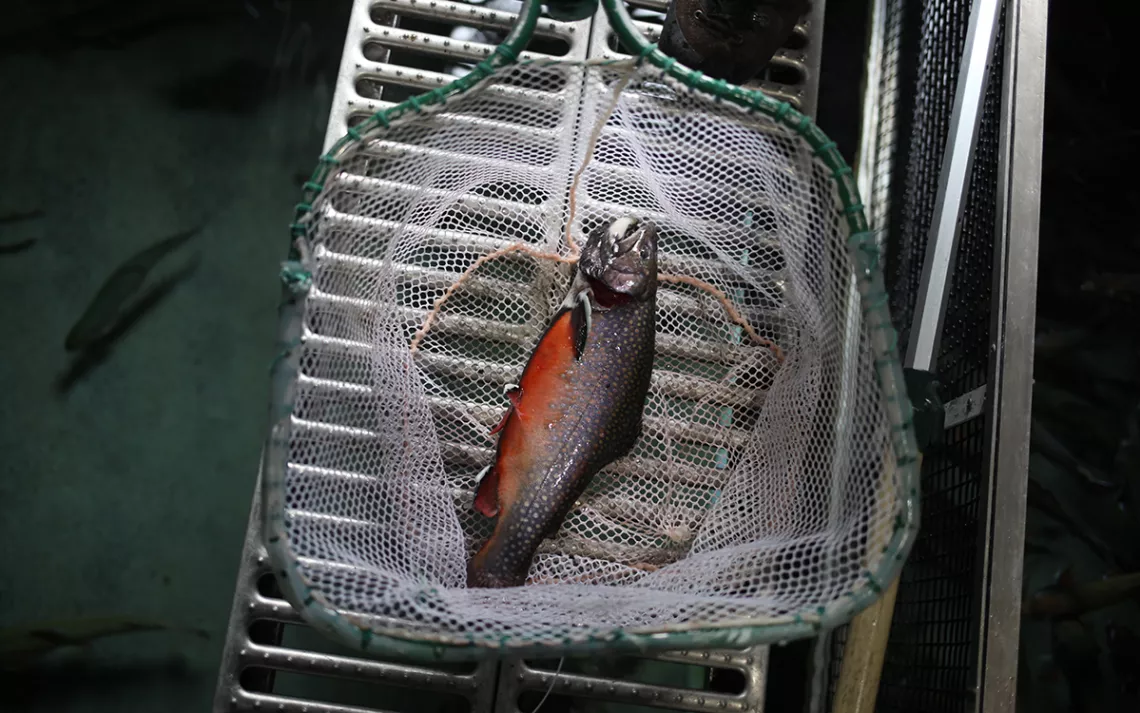
A Trojan brook trout reared at the Hayspur Fish Hatchery near Sun Valley, Idaho. | Photo by Jeremy Miller
This story originally appeared in bioGraphic, an online magazine about nature and sustainability powered by the California Academy of Sciences.
On a golden morning in early October, two graduate students from New Mexico State University plunge into the icy current of Leandro Creek. The small waterway flows through the 550,000-acre Vermejo Park Ranch, a reserve in the Sangre de Cristo Mountains of northern New Mexico. Today, the crew will trace the stream’s course toward its headwaters on the flanks of a volcanic cone called Ash Mountain, in search of an unusual fish.
Kelsie Field, 25, a graduate student in the Department of Wildlife and Conservation Ecology wears a pair of worn gray waders and totes two 8-gallon buckets, one full of water, the other, of scientific gear—test tubes, an electronic scanner, surgical implements. Michael Miller, 30, a fellow graduate student in the same department, also clad in waders, shoulders a large, waterproof backpack containing a battery attached to an electrode that resembles a metal detector like those used by treasure hunters.
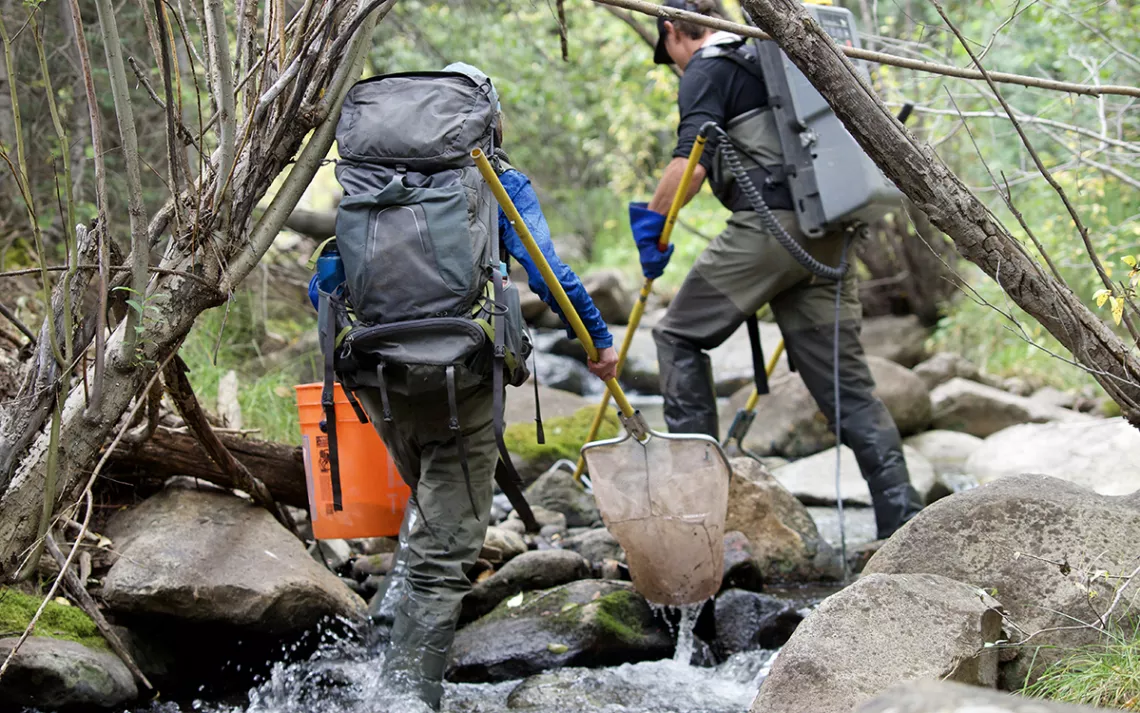
Michael Miller and Kelsie Field, graduate student researchers from New Mexico State University, electrofish a small stream that runs through Vermejo Park Ranch.
This, Miller dips into the creek, squeezing the handle to send some 300 volts through the water. While the crew’s rubber boots insulate them from the shock, the resident fish are exposed to the electrical current. Stunned, they drift to the surface just long enough for Miller to net them and deposit them in Field’s bucket. Most measure around 10 inches. Some are no larger than a pinky. Occasionally, though, Miller’s handle bends sharply as he nets a hunchbacked specimen of 16 inches or more—apex predators gorged on smaller fish, in this waterway scarcely wider than a city sidewalk.
There are just two species here. One is an embattled native, the Rio Grande cutthroat trout (Oncorhynchus clarki virginalis), distinguished by its cream-colored skin, mottling of black spots and a vibrant orange slash under the jaw. Once widely distributed in rivers and streams across northern New Mexico and southern Colorado, the Rio Grande cutthroat is now found across a mere 10 percent of its historical range. And like others among the dozen or so subspecies of cutthroat trout in the western United States, today it’s reeling under the pressures of climate change, habitat loss, and—in the case of Leandro Creek—a hardy intruder.
Which brings us to the more prolific species writhing in Miller’s net—the brook trout (Salvelinus fontinalis). The smaller “brookies” are sleek and silvery. The adults, though, wear their spawning finery, their sides a riot of red and blue spots, their bellies orange as a ripe mandarin. The fish’s colors are otherworldly, as if they have somehow absorbed into the riotous canvas of their skin the ragged beauty of the place in which they live.
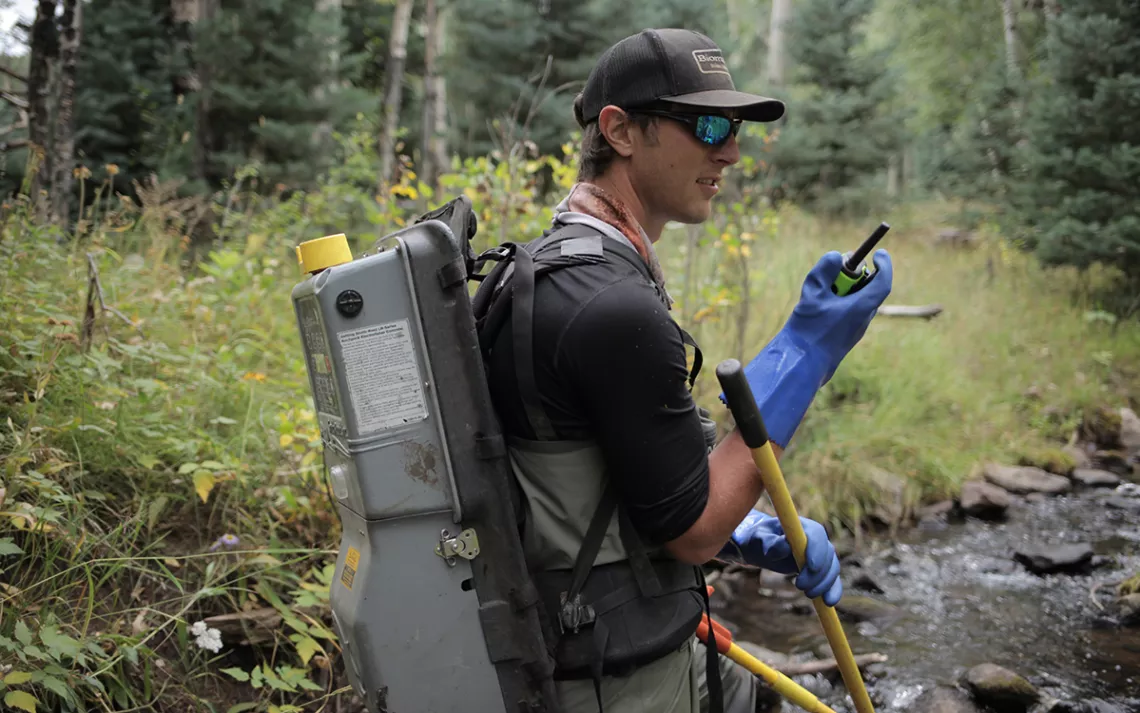
Michael Miller, a graduate student at New Mexico State University. | Photo by Jeremy Miller
How this beautiful interloper from eastern North America got to this place is unclear, beyond that it was part of a human-aided diaspora that loosed brook trout into high-altitude lakes and creeks across the West, from northwest Washington to southern New Mexico. There, brookies’ voracious appetites and rapid sexual maturation have spelled trouble not only for native trout like bull, rainbow, California golden, and cutthroat, which they outcompete, but also for a host of other aquatic organisms, including frogs and salamanders.
As Miller and Field shock and scoop their way upcreek, though, a pattern that could be the key to Leandro Creek’s salvation becomes apparent. Brook trout may greatly outnumber the Rio Grande cutthroat here, in some stretches by more than five to one, but nearly every single one of the brookies the crew captures is male.
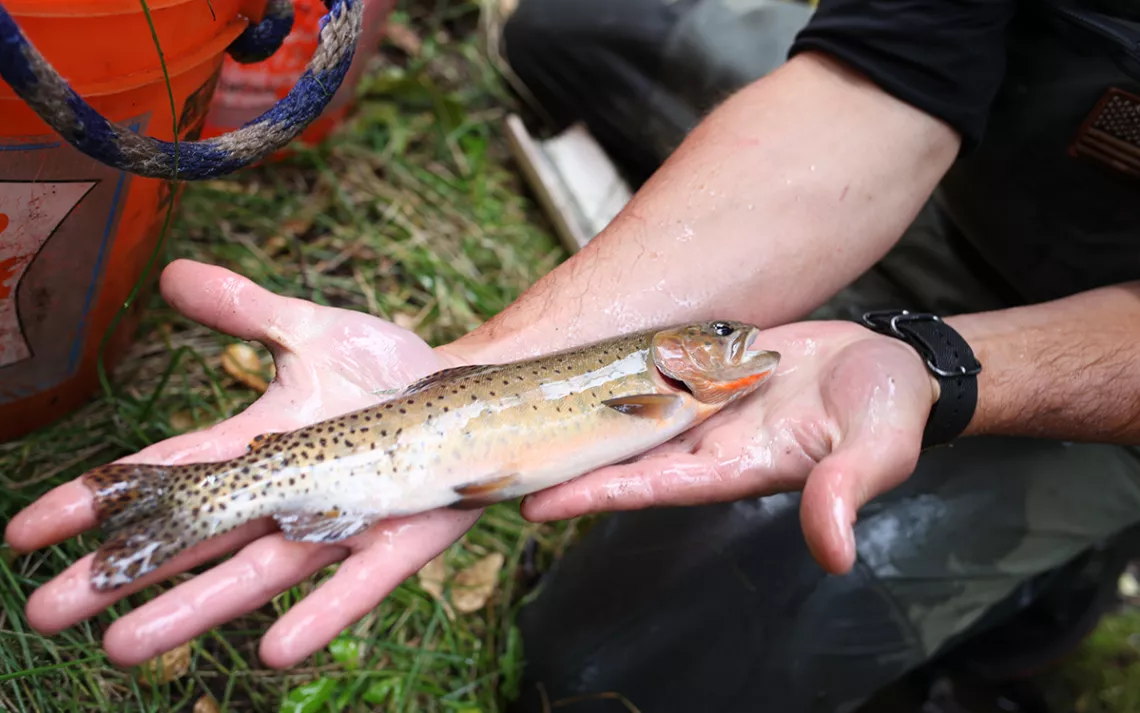
Researcher Michael Miller presents a cutthroat trout from a small stream on Vermejo Park Ranch. | Photo by Jeremy Miller
That’s because many are a lab-produced variety known as “Trojan” brook trout. They are unique in that they carry not one, but two copies of the Y chromosome that codes maleness; they have no X chromosome to pass on. Unlike many creatures, including humans, fish can survive without an X, and seem unimpaired by the lack. And since 2018, Miller, the lead researcher on the project, and his predecessors have been carrying out a bold new experiment, stocking various streams across the Vermejo reserve with this strain in an attempt to tilt the brook trout sex ratio so far male that eventually the population will stop breeding and blink out on its own. Similar efforts are also underway in a handful of creeks in Idaho, Washington, and Oregon, and Nevada plans to embark on its own stocking program this summer.
Until now, the main tool to eliminate invasive fish species has been the potent chemical rotenone. The trouble is that “it also kills all the other fish, including the ones you are trying to conserve,” says Colleen Caldwell, a professor of fish and wildlife at New Mexico State University and a principal investigator overseeing the Leandro Creek project. Researchers are still trying to understand if Trojan trout behave enough like wild male trout to convince females to breed with them, as well as whether they can thrive enough in their new environment to tip the scales in the Rio Grande cutthroats’ favor. But the hope is that managers can use the imposters as a precision scalpel to excise brookies from stream systems, rather than bombing them with an indiscriminate chemical agent.
Despite the method’s promise, modifying organisms into flesh-and-blood weapons to achieve ecological ends raises questions about both ethics and unforeseen outcomes. “No matter what people say, the long-term effects of these things are just unknown,” says Marc Bekoff, an emeritus biology professor at the University of Colorado-Boulder and a prominent behavioral biologist. “Their goals might seem laudable today, but with rapidly reproducing organisms, you might not even know what’s going to happen in half a year.”
Is the Trojan brook trout a more humane tool for saving native fish, as its proponents insist? Or will it cause its own cascade of problems—a 21st-century version of what well-meaning people wrought when they unleashed its ancestors?
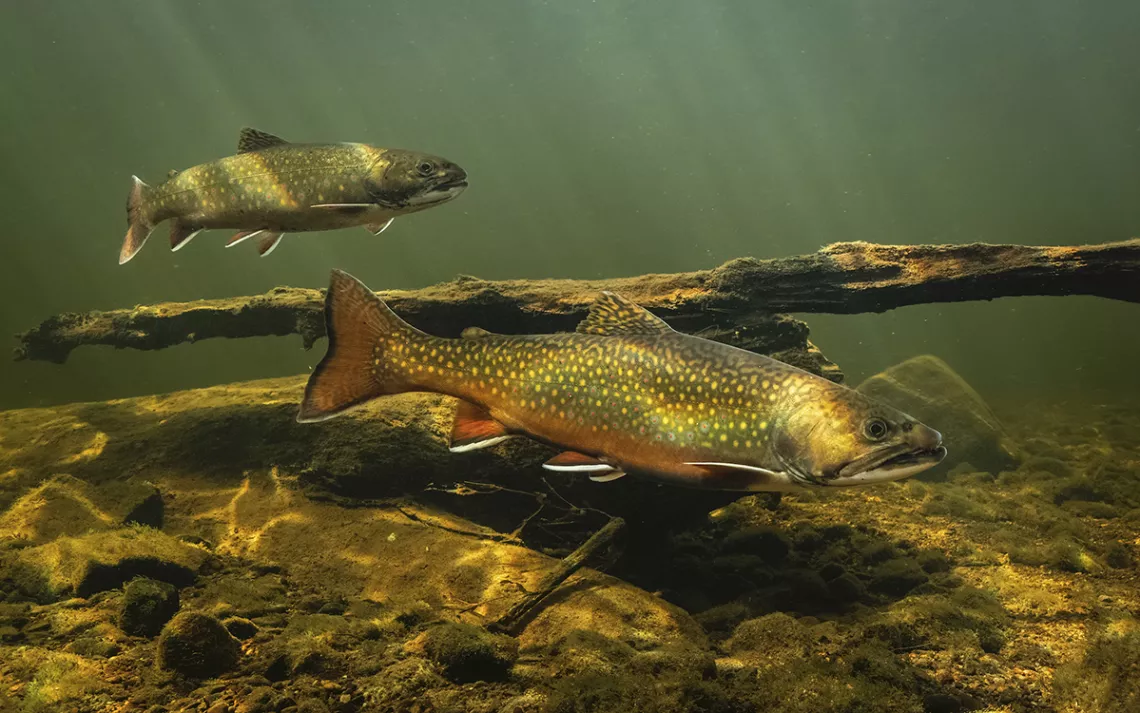
Brook trout, native to the eastern United States, made their way into streams and lakes across the West thanks to European settlers looking to bring with them a small, living piece of their adopted homeland. | Photo by Nick Hawkins
Brook trout are, in some ways, a good problem to have. They can live only in clean, cold water, so their presence indicates a waterway untainted by pollution. Fittingly, their scientific name, Salvelinus fontinalis, translates to “living in springs,” evoking the frigid, rushing streams where the fish thrive. Twenty thousand years ago, at the height of the Pleistocene, brook trout were confined to waterways at the margins of glaciers, which extended deep into the interior of North America. As the glaciers ebbed, the species spread throughout the Appalachians, Great Lakes, and deep into the Canadian interior. But an insurmountable natural barrier stopped their spread farther west: The Mississippi River was too warm for them, barring access to high-altitude waterways on the other side of the continent.
It was newly arrived Europeans who helped them cross that barrier—and in large numbers. As the American frontier expanded, settlers, perhaps nostalgic for a living piece of their adopted eastern homelands, planted brook trout in streams and lakes in the Rockies, Cascades, and Sierra Nevada. The railways sped the brook trout’s westward migration, with trains carrying specially designed “fish cars” filled with eastern species, including striped bass, brown trout, and brook trout. The fish-laden trains traveled the rail lines along the shores of rivers and lakes. From there, the piscine cargo could easily be transferred—by way of trucks or milk cans hauled by hand—into the water.
A pseudoscientific concept known as “acclimatization,” in vogue in the late 19th century, also accelerated the process. Contrary to today’s environmental orthodoxy, adherents believed that introduced species improved ecological conditions. As author Kim Todd writes in Tinkering With Eden, “Ponds and lakes, rather than being viewed as complex ecosystems, were treated as outdoor aquariums waiting to be filled.” Even the Sierra Club, which now runs campaigns against invasive species, was involved, transplanting large numbers of brook and other trout into lakes and streams along its guided routes through the High Sierra so that paying customers could have an “authentic” wilderness experience.
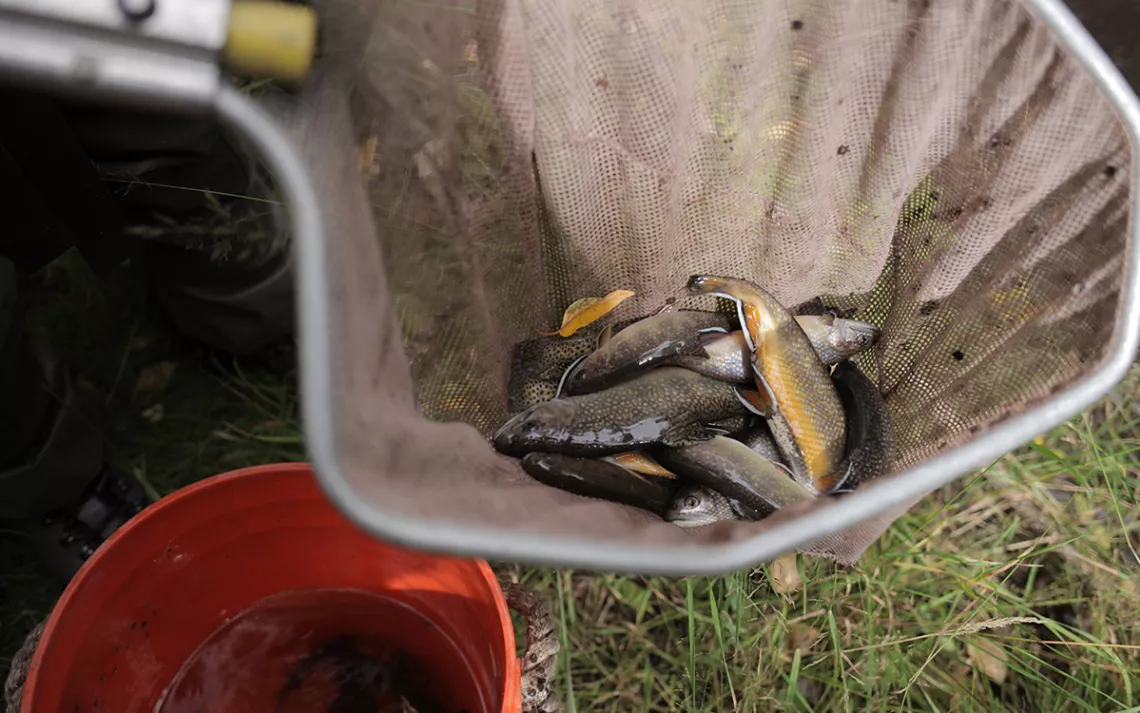
Trojan brook trout in a small stream in New Mexico's Vermejo Park Ranch. | Photo by Jeremy Miller
Perhaps the single most prolific transplanter of brook trout was Finis Mitchell, a Wyoming railroad worker turned fishing guide. During the Great Depression, Mitchell and his wife, Emma, carried an estimated 2.5 million fingerling brook, rainbow, golden, and brown trout in milk cans to lakes across Wyoming’s Wind River Range. “These waters were all virgin and were just full of water lice, leeches, freshwater shrimp,” Mitchell wrote in his slim guidebook and memoir Wind River Trails. “[T]hose fish just gorged themselves. Some of the brook trout weighed three pounds [after] the third year.”
Later, state and federal wildlife officials stocked remote lakes from airplanes and helicopters for the benefit of anglers—a practice that continues to this day. By these thousands of acts, the brook trout became a fixture—and, by most ecological measures, a pest—in waterways across the West. “I remain fully confident that if a nuclear holocaust should eliminate most of Earth’s life forms,” wrote Edwin Pister, a long-time fisheries biologist for the California Department of Fish and Game, “survivors would include not only cockroaches but brook trout as well.”
As a destructive force, they have had plenty of company. Forty-two percent of endangered species in the US have been “significantly impacted” by invasive species, according to the federal Environmental Protection Agency. Among aquatic species, the numbers are starker, with invasives implicated in 70 percent of extinctions.
After the passage of landmark environmental laws like the National Environmental Policy Act and the Endangered Species Act in the 1970s, fisheries managers began a slow pivot away from their primary mission of rearing and releasing fish. Today, though they still stock some sport fisheries, state and federal wildlife agencies also work to restore the native populations and ecosystems they helped compromise, by joining the war on invasive species. In the case of brook trout, they’ve waged that war with massive volumes of poison and vast piles of tax dollars, often with little result.
Enter the Trojan brook trout.
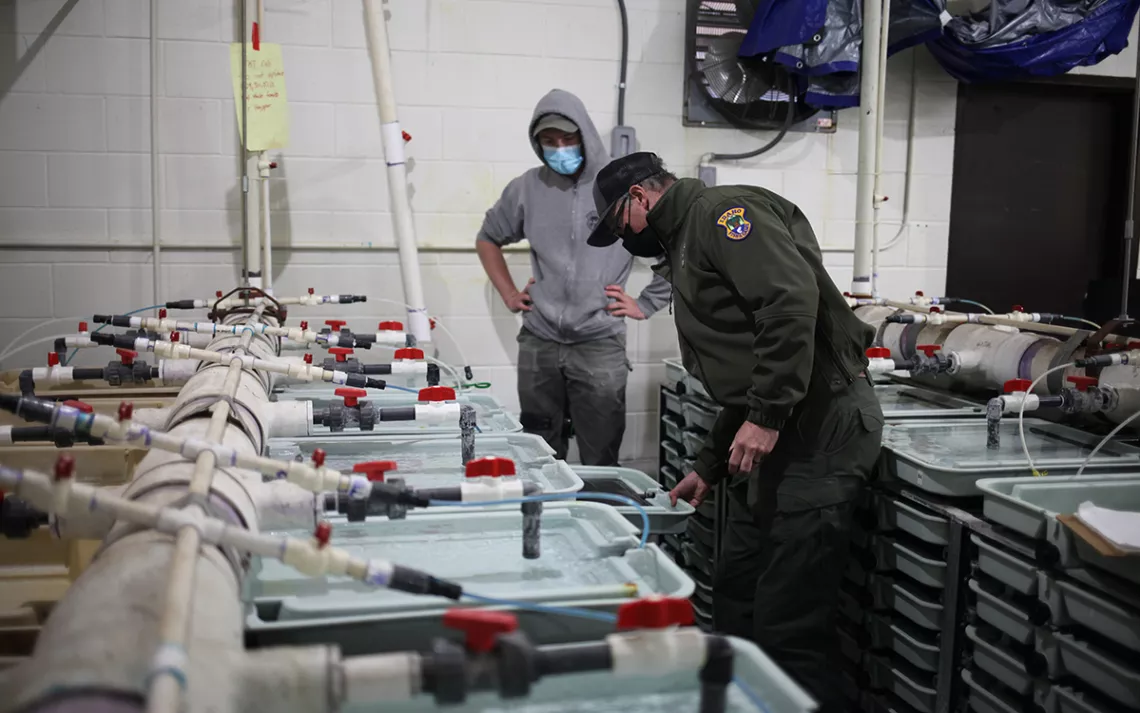
Fish culturist Tom Lindenmuth oversees the Trojan trout rearing operation at the Hayspur Fish Hatchery. | Photo by Jeremy Miller
On a snowy day in November, I visit the Hayspur Fish Hatchery, near Sun Valley, Idaho. The Trojan brook trout that inhabit Leandro Creek were made here, as were those plying streams in other states. Tom Lindenmuth, a fish culturist and manager who oversees the operation at the 115-year-old state hatchery, greets me at the front door, pulling his mask tightly over his nose, which accentuates his nasal northern-tier accent and causes his glasses to fog up. “Sorry, but the state says we’ve got to wear these,” he says.
The program got its start in 2008 at a different Idaho hatchery, the brainchild of Dan Schill, a now-retired fish biologist from the Idaho Department of Fish and Game. Born and raised in western Pennsylvania, Schill grew up fishing for brookies in the wooded creeks of the East and developed an ambivalence toward the species that drove his work. “The reason I’m a trout stream biologist is because I fell in love with the native brook trout in western Pennsylvania,” he tells me. “But of course out west they’ve had a pretty darn negative effect, particularly on our cutthroat stocks.”
Schill first encountered the idea of producing super-male fish when a presenter at a conference offhandedly mentioned something called the “Trojan Y chromosome approach” near the end of a talk. “It was all a theoretical thing,” he recalls. “But it said if you could create a YY broodstock of an invasive fish and put it on the landscape then, in theory, you could shift the sex ratio to all males.” The process begins with forcing male brook trout to undergo a sex change.
My first stop with Lindenmuth is the brick edifice of the incubation building, where this transformation takes place in dozens of blue cylindrical tanks. Inside these early-rearing vats are dozens of “larval” male brook trout, which look more like tiny brine shrimp with their egg sacs still attached. Once the sacs have been absorbed and the fish are ready to feed, attendants give them food coated with estradiol, a form of the female hormone estrogen. Over a two-month period, the estradiol turns their sperm-producing testes into ovaries, and the genetically male fish become capable of laying eggs. But the process doesn’t end there.
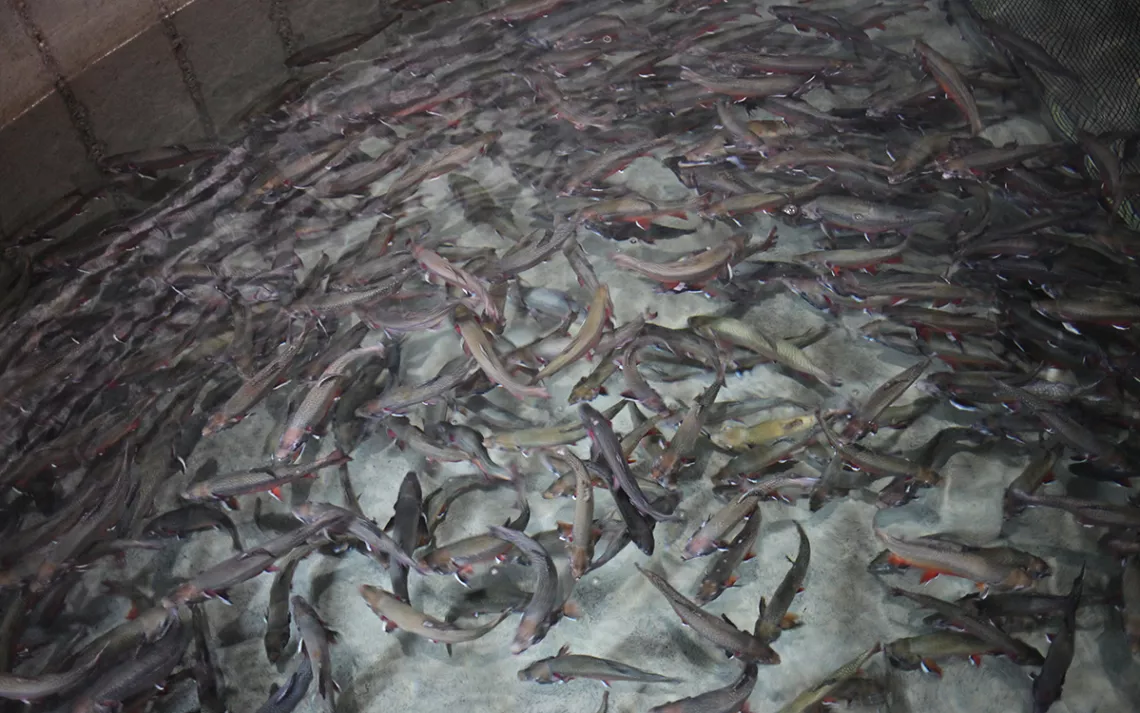
At the Hayspur Fish Hatchery | Photo by Jeremy Miller
When hatchery workers breed these fish with normal XY males, 25 percent of their offspring will be female with two X chromosomes. Fifty percent will be typical males with an X and Y chromosome. But 25 percent will be the special variety key to the genetic population control scheme: males with two Y chromosomes. Some of the YYs will be given estradiol, causing them to form ovaries and produce eggs. These “feminized” YY fish are then crossed with YY males to create the hatchery’s broodstock. The other YYs will be transplanted into streams. If and when these “super-male” brook trout fertilize the eggs of wild female brook trout, they will produce 100 percent male offspring.
Opposite the rearing vats, Lindenmuth shows me several rows of incubation cabinets filled with dozens of small trays divided into squares. Within each square are hundreds of brook trout eggs, the lot of which were laid by a single feminized YY male. He removes a tray and gently scoops up a handful of glistening, golden spheres. The eggs, he explains, will be treated with Ovadine, a chemical that strengthens their shells for shipping—so much so that they will bounce “like a rubber ball” if dropped on the floor. Then, they will be packed in wet paper towels and ice and mailed to hatcheries in Washington, Oregon, Nevada, and New Mexico.
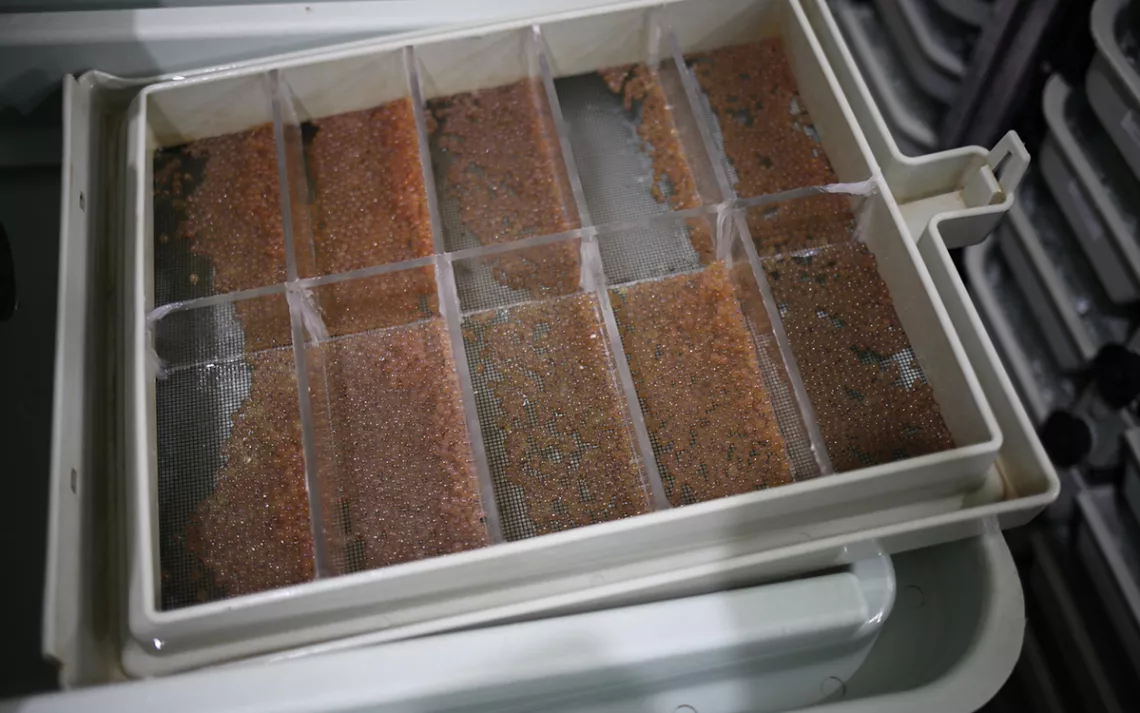
Trays of trout eggs await shipping to hatcheries in Washington, Oregon, Nevada, and New Mexico. | Photo by Jeremy Miller
To keep estradiol from leaching into surrounding waterways and causing a similar sex transformation in wild fish, Lindenmuth says, the hatchery uses a sophisticated water recycling system comprised of several large, wall-mounted charcoal filters, which cleanse hundreds of gallons of water every hour before discharging it to a septic system. And because the fish directly exposed to estradiol never leave the hatchery, Lindenmuth explains, there is no danger that they will dose waterways, or fishermen who might catch and eat them, with a concentrated dose of hormones.
We leave the incubation building and make our way across the snowy ground to two metal silos that house sexually mature broodstock fish after they’re sorted. Within each building is a tank divided by a central barrier. Lindenmuth walks out onto the narrow walkway above one. On the left side, a school of sperm-producing YY males swims frenetically in a kaleidoscopic swirl, easily a hundred strong. On the right, a school of feminized, egg-laying YY males cruise along the tank’s perimeter.
Lindenmuth grabs a long-handled net and jabs it into the left side of the tank. The metal pole strains and bounces as he withdraws a fish, then places the net flat on the walkway. Nearly two feet long and weighing a pound and a half, the fish is a YY male. In the dim light, the blood-red slash of its gills glows against the metallic sheen of its skin. Here lays the biological scalpel. But I have to wonder: Does this blade cut both ways?
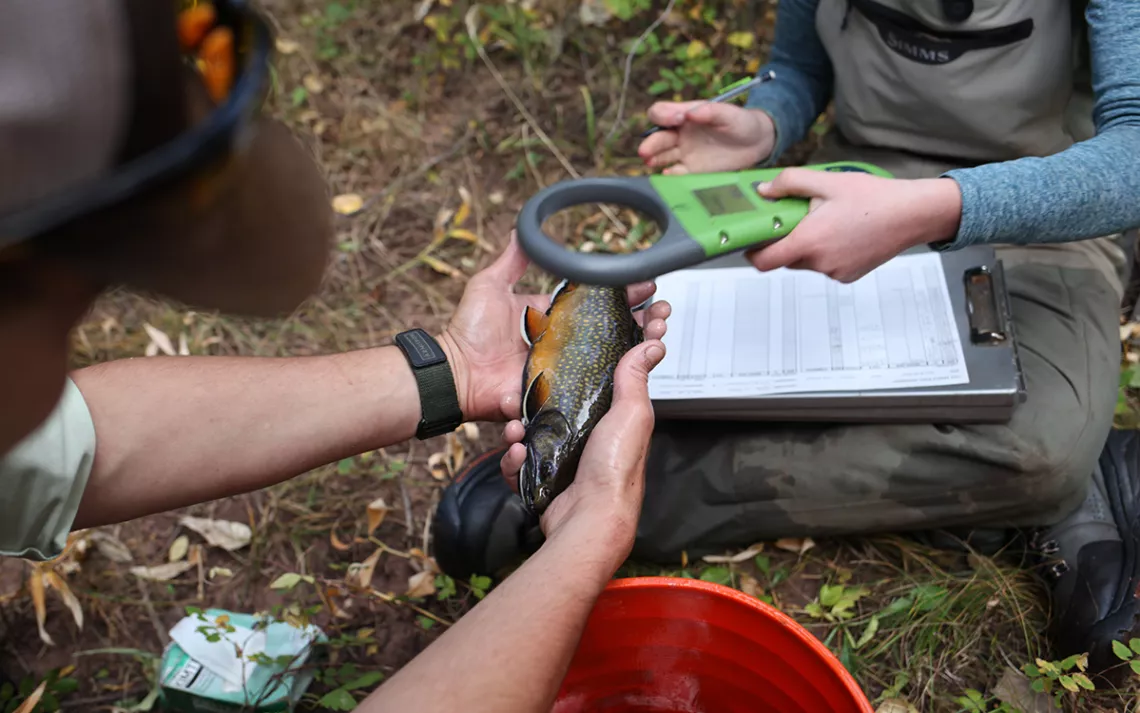
Miller and Field scan a brook trout. | Photo by Jeremy Miller
Back at the Vermejo reserve, Miller and Field continue upstream. Every 50 meters, they pause and sit on the streambank at designated intervals marked with pink flagging to take stock of their catch. Miller reaches into the ice-cold water of the bucket. Suddenly his forearms tense and he raises a sleek silhouette—another YY brook trout. Well over half the fish they count at this given waypoint are of the Trojan variety. Field makes quick swipe of the fish with a handheld scanner, which returns a beep. This indicates that the fish contains a scannable PIT tag, no larger than a grain of rice, which contains vital information such as where and when the fish was hatched and when it was released. As Field jots the measurement onto a spreadsheet, Miller inspects the fish quickly, sliding thumb and index finger along its underbelly, which produces a spurt of milt, a milky substance containing sperm. Miller then notes the missing adipose fin, clipped by workers at the Los Ojos Hatchery, near Chama, months earlier—another clear sign that this is a Trojan.
The team, now joined by seasonal field technicians Cameron Cole and Valentin Perez, who earlier were electrofishing a rugged stretch of the upper watershed, quickly counts the larger fish. Then Miller delicately retrieves the fingerlings from the bucket, enthusiastically calling out “genetics!” These small fish are cause for excitement because they may be the offspring of YY males that are breeding with wild females in the creek. By the end of the second spawning season, in 2020, 75 percent of the fish captured in Leandro Creek were male. Moreover, almost 30 percent of the juveniles captured from test streams around Vermejo were the male offspring of YY brook trout, according to lab analysis of a specific sex-marker in the fish’s genes. Miller hopes this year’s percentages will be higher. Only a genetic test will tell for sure. Using a small pair of surgical scissors, Miller cuts away part of the fish’s anal fin, then drops it into a vial, which will be sent to a lab for analysis.
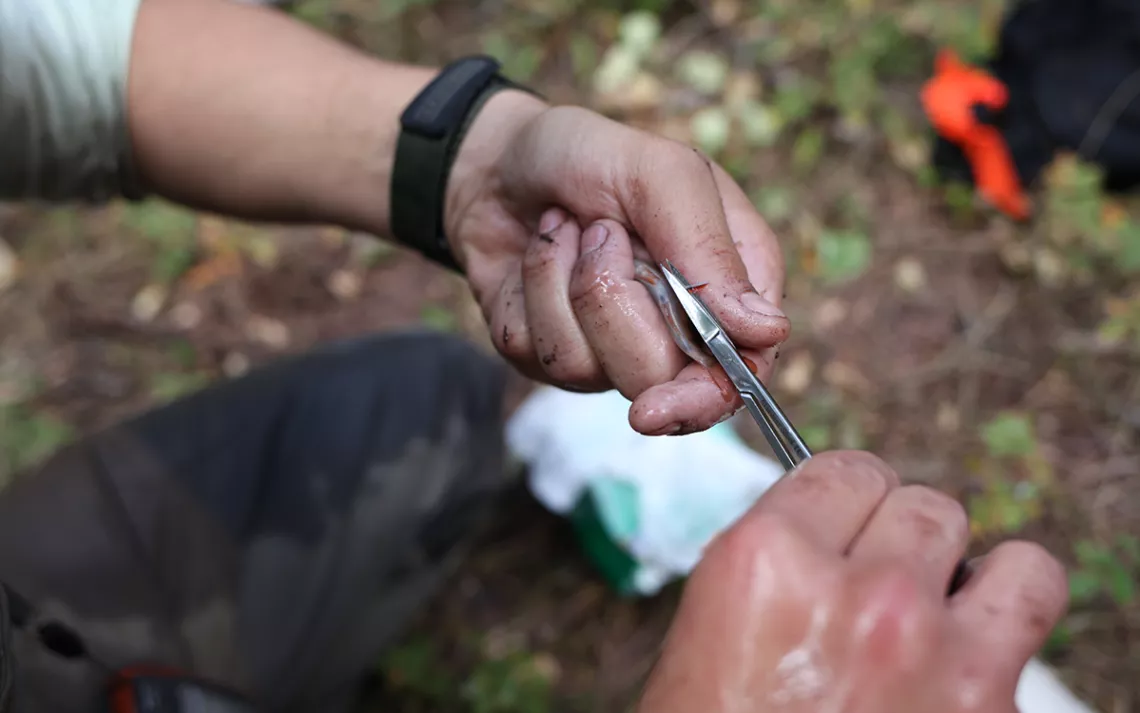
Researcher Michael Miller snips off a small piece of fin from a young brook trout. | Photo by Jeremy Miller
The debate around genetically modified organisms, or GMOs, and their potential to harm native species is a heated one. But while there is little doubt that scientists have reshuffled the Trojan trout’s existing chromosomes, they haven’t inserted any foreign genes into their DNA, says Schill. That makes them different from a GMO, like, say, the AquAdvantage salmon featured in a previous bioGraphic story. This “transgenic” strain of Atlantic salmon, produced in a lab for farming, contains a gene inserted from Pacific Chinook salmon that allows the fish to grow faster than their wild counterparts. Opponents fear that these genetically altered salmon—which they call “Frankenfish”—could outcompete or pass their genes along to wild Atlantic salmon populations.
Chemically altering an organism in pursuit of a conservation goal might seem unconventional, but “it’s not a radical departure from the kinds of things that conservationists are generally trying to do,” says Ron Sandler, a professor of philosophy at Northeastern University who specializes in bioethics. And it’s much less radical than “assisted evolution,” where novel genes are inserted to make creatures better suited to cope with human-altered environments. Sandler points to a new strain of American chestnut that biologists have modified with genes from wheat plants to make them more resistant to the fungal blight that nearly wiped out the trees, which once covered a vast swath of the eastern US. “While these techniques might be effective at targeting a few high-interest species, they’re not an effective tool against the bigger crisis,” says Sandler. “They don’t address the underlying causes, which are emissions, extraordinarily high levels of consumption, and human population growth.”
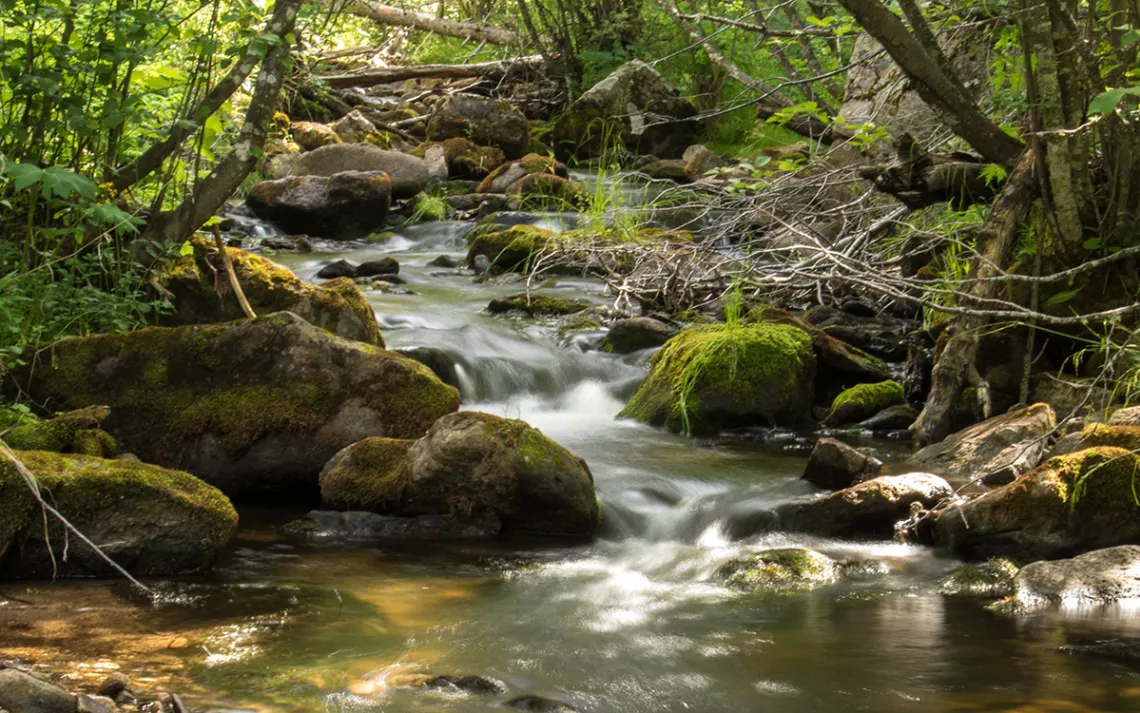
New Mexico's Pecos Wilderness provides perfect habitat for cutthroat and brook trout alike. | Photo by Christina Selby
There are other ethical issues to consider too. Marc Bekoff from the University of Colorado says the approach treats the significant alteration and potential suffering of animals too blithely. “If someone said to me, ‘We’re going to turn you from a male to a female,' I’d say, ‘I don’t want to be.'” Fish, of course, cannot express their consent. Bekoff, who advocates for a humane approach called “compassionate conservation,” praises the effort to find a nonlethal means to control brook trout populations, but says that scientists all too often forsake the lives of individual organisms for the perceived needs of populations and ecosystems.
And therein lies the bigger problem, says Bekoff: There may be unforeseen consequences from using rapidly reproducing, modified non-native animals as a form of biological control. “You could produce a nightmare very quickly,” he says.
Take, for example, the famous case of the cane toad (Rhinella marina) brought from Central and South America to Australia in 1935 to help with native beetles that were ravaging the country’s sugarcane fields. Though hailed as an ecologically friendly alternative to pesticides, the toads became a disaster of their own, devouring the continent’s endemic lizards, snakes, and birds in massive numbers. Today, Australia’s population of cane toads is estimated at 200 million despite numerous efforts at eradication, all descended from an introduced population of just 100.
Schill dismisses the possibility of such a disaster at Vermejo and other creeks because the underlying ecological context is different. Unlike the toads, brook trout have already colonized the streams into which the new strain is being introduced. Moreover, those streams have barriers—some natural and others manmade—that prevent their movement out of the study area. And since brook trout and cutthroat trout are genetically incompatible and can’t breed with one another, there is no risk of creating hybrids.
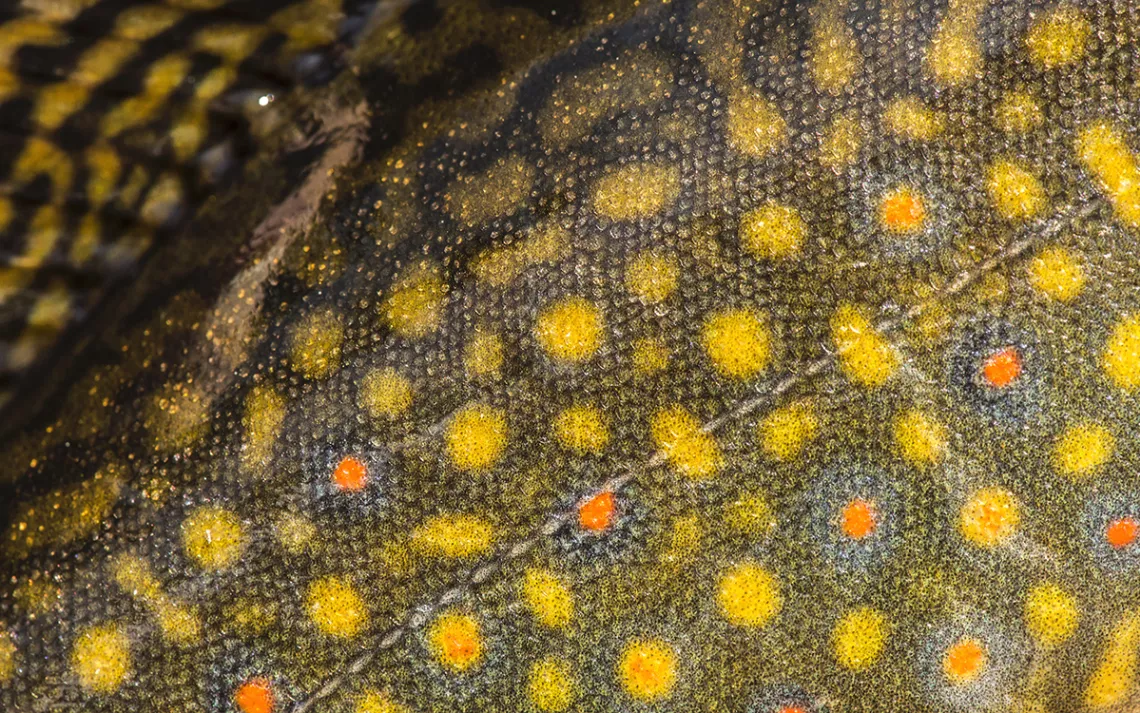
These colors and patterns are typical of a male brook trout. | Photo by Jeremy Miller
However, some biologists do worry about YY brook trout released into Idaho streams that contain native bull trout. Unlike Leandro Creek’s cutthroat, the bull trout, Salvelinus confluentus, is closely related to brook trout and the two can produce hybrid offspring. This interbreeding has decimated bull trout populations across their range and is one of the reasons the species is listed as threatened.
“Any kind of hybridization is a bad thing when it comes to bull trout,” says Patrick DeHaan, a geneticist with the US Fish and Wildlife Service who has studied the hybridization of bull and brook trout. “I’d like to see more data and population modeling before saying that this is a safe method for eliminating brook trout from streams that still contain bull trout.”
For his part, Schill, too, says he’d like to see more funding for such studies. But time is short, he adds, and as science plays catch-up, brook trout continue their advance. Managers at the Idaho Department of Fish and Game see YY fish as a last resort to save the bull trout from extirpation in the state, Schill says. “As soon as we can show this works, the Trojan brook trout are going in. You know why? Because without them, the bull trout have no chance.”
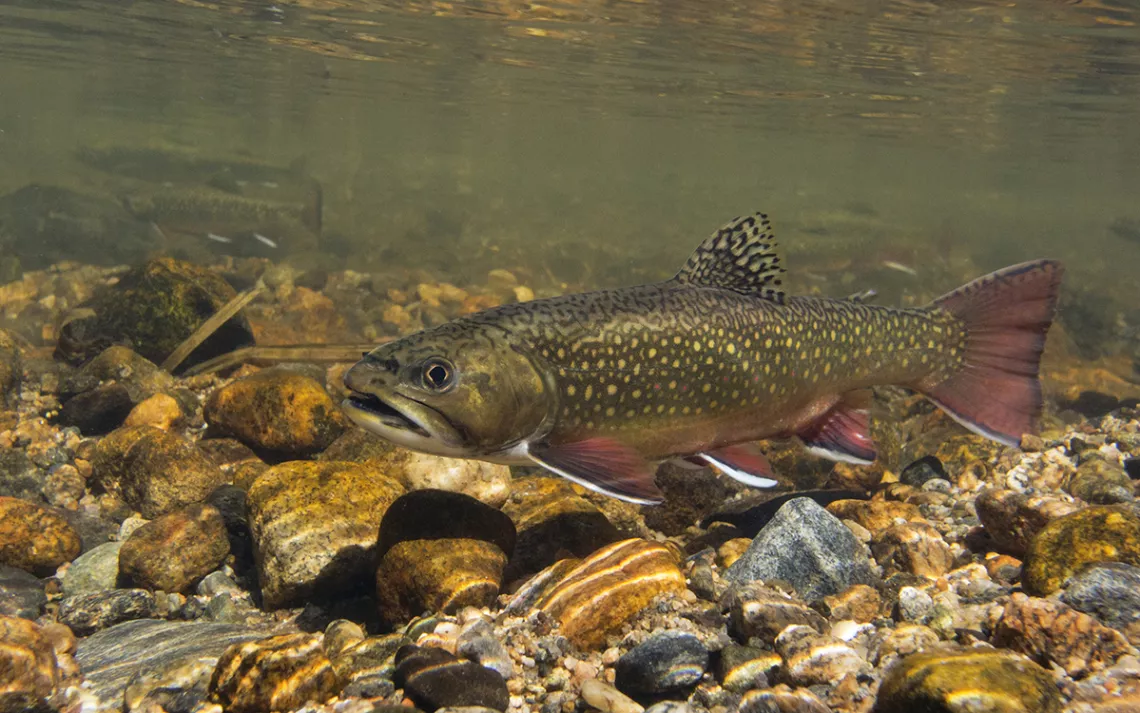
Brook trout | Photo by Charlie Summers
The descending sun casts a warm glow on Leandro Creek as the workday approaches its end. Miller and Field have caught, measured, tagged, and released hundreds of fish. By the time they reach the last pink flagging, another pattern has emerged: Leandro Creek’s Trojan brookies appear to be thriving and the cutthroat, though fewer in number, are holding their own.
That night, we huddle around a roaring fire to thaw away the chill from hours wading through icy water. Stars flicker into view above Ash Mountain, and in the quiet, we can hear the static of the creek. Miller and Field sip beers and reflect on the waterway’s possible future. Given enough time—anywhere between five and 15 years, if predictions hold—brook trout reproduction could cease, and Rio Grande cutthroat populations could reclaim their stream, says Miller. “Some waterways have been modified beyond any hope of repair. But in other places, we have the ability to fix our mistakes. We have an ethical responsibility to do what we can, where we can, to restore that natural history.”
As I listen, I’m reminded of an irony befitting our troubled ecological times: This effort to remove brook trout from the West is happening at the same time as the species is losing ground in huge areas of its native range in the East. Logging, mining and fracking have befouled miles of streams and lakes, and acid rain from coal-burning power plants and factories lowered the pH of mountain lakes at heart of the brook trout’s range. Suburban and exurban sprawl has also done immense harm. One study found that brook trout rarely survive in watersheds in which more than 4 percent of the land is paved. Global warming has raised water temperatures in large portions of the fish’s home range above 68 degrees Fahrenheit, a critical threshold beyond which it cannot survive. In Maryland, brook trout have already disappeared from 62 percent of their historical habitat, and if current rates of warming hold, the species could vanish entirely from the state by century’s end.
To compound the irony, invasive species may pose the gravest threat to brookies, says Schill. On a recent trip home to Pennsylvania, he clambered through thick rhododendron to reach a small brook trout stream that he had fished often in his youth. When he flicked out a cast and felt a tug, he expected to see the telltale orange belly and red and blue spots of a brookie. Instead came the silver flash of a West Coast transplant, Oncorhynchus mykiss, the rainbow trout. Rainbow trout, which were introduced in vast numbers to lakes and rivers in the Appalachians at the same time brook trout were being planted in the Rockies and Sierra, happen to be more heat tolerant and able to thrive in eastern waterways rapidly becoming uninhabitable to brook trout.
The technology employed in removing the brook trout from the West, says Schill, who now works as a fisheries consultant, may prove critical to the species’ survival in the East. “There are people in the southern part of the range, in Tennessee and North Carolina, that are interested in creating a YY rainbow trout,” he tells me. “I’m in discussions with them now.”
 The Magazine of The Sierra Club
The Magazine of The Sierra Club



